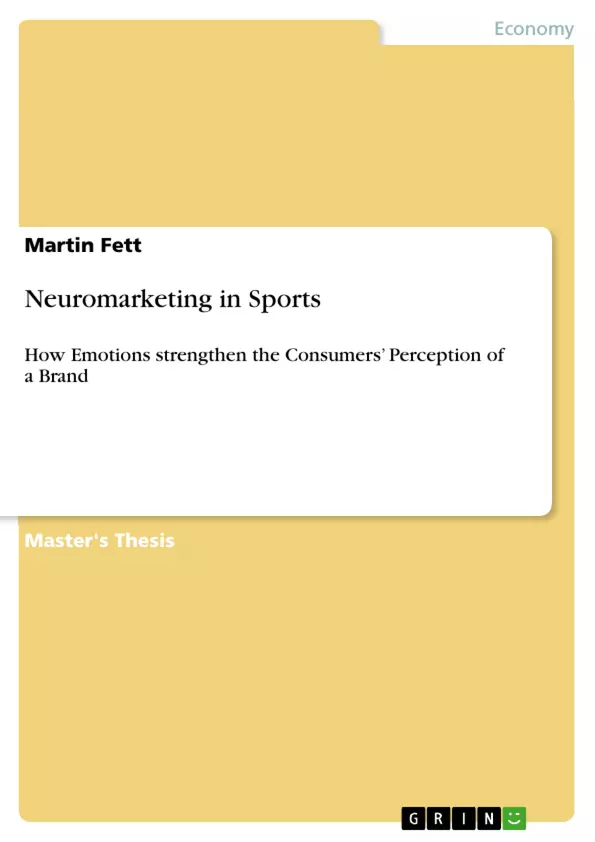Until now, economic theory has not systematically integrated the impact of emotions
on brand perception. Evidence from the evolving discipline of neuroscience suggests
that decision-making is dependent on emotional processing. Interdisciplinary research
under the label of “neuromarketing” arose. The key idea of this approach is to employ
recent neuroscientific methods in order to analyze economically relevant brain
processes. This thesis offers an overview of the current state of neuroeconomic
research by defining the concept of neuromarketing, explaining methods that are
widely used and describing current studies in this new research area. The study which
was conducted within this master thesis finally provides guidance for future research.
Several studies found that there are no separated ways for cognition and emotion in a
human being’s brain. Emotions are deeply connected with cognitive processing and
thus, even are a crucial part of human decision making.
Since more and more companies want to enhance their brands, products, and services
with emotions, they are trying to use this important precondition and are engaging in
sports sponsorships, because sports as such is considered the biggest and most
emotional power in entertainment business.
Several authors claim that in addition there has rarely been coherent research for
sponsorship in general – and if at all, then only regarding the awareness of the
sponsoring brands. Also, companies are not really aware if they seize the high potential
of their sponsorship activities. About 21% of companies that apply sponsorship
strategies into practice do not even conduct a controlling phase. They are not
measuring the achievement of their sponsorship objectives. Hence, they do not even
know the success (or failure) of their strategies. Does sponsorship in sports have
significant effects at all? Does it help to increase a brand’s image?
Only explicit measuring is very common in controlling the effects of sponsorship
activities. The probands are being asked whether they remember one brand or another
and how they rate it. Too often, however, the results are biased by many wrong preconditions, for example the Social Desirability Bias or that the sponsors only want
to hear what they want to hear.[...]
Inhaltsverzeichnis (Table of Contents)
- Abstract
- Preface
- 1 Introduction
- 1.1 Motivation and Goal of the Thesis
- 1.2 The Role of Emotions in Decision Making
- 1.3 The Impact of Emotions on Brand Perception in Sports
- 2 Neuromarketing
- 2.1 The Rise of Neuromarketing
- 2.2 Methods of Neuromarketing Research
- 2.3 Applications of Neuromarketing in Sports
- 3 Sponsorship in Sports
- 3.1 The Sponsorship Market
- 3.2 Effectiveness of Sponsorship Strategies
- 3.3 Measuring the Impact of Sponsorship
- 4 Empirical Study
- 4.1 Research Design
- 4.2 Methods and Procedures
- 4.3 Data Analysis and Results
- 5 Discussion
- 5.1 Key Findings of the Study
- 5.2 Implications for Sponsorships in Sports
- 5.3 Limitations and Future Research Directions
- 6 Conclusion
Zielsetzung und Themenschwerpunkte (Objectives and Key Themes)
This master's thesis explores the application of neuromarketing techniques to analyze the impact of emotions on brand perception in the context of sports sponsorships. It examines the current state of neuroeconomic research, reviews existing methods of neuromarketing, and conducts an empirical study to investigate the effectiveness of sponsorship strategies using implicit measuring methods. Key themes and objectives of the thesis include:- The role of emotions in decision-making and brand perception.
- The application of neuromarketing methods to measure implicit consumer responses.
- Investigating the effectiveness of sponsorship strategies in sports.
- Identifying the potential benefits and limitations of neuromarketing in sponsorship research.
- Exploring future research directions for neuromarketing in sports.
Zusammenfassung der Kapitel (Chapter Summaries)
- Chapter 1: Introduction: This chapter establishes the motivation and goal of the thesis, highlighting the importance of understanding the role of emotions in brand perception and decision-making. It explores the potential of neuromarketing to provide insights into consumer responses to sponsorships in the realm of sports.
- Chapter 2: Neuromarketing: This chapter provides an overview of the emerging field of neuromarketing, defining its key concepts and discussing various methods used in neuroeconomic research. It examines the potential applications of neuromarketing in analyzing consumer behavior and brand perception in sports.
- Chapter 3: Sponsorship in Sports: This chapter analyzes the sponsorship market in sports, exploring the effectiveness of sponsorship strategies and discussing the challenges of measuring their impact. It explores the limitations of traditional methods and highlights the need for new approaches to assess sponsorship effectiveness.
- Chapter 4: Empirical Study: This chapter outlines the research design, methods, and procedures used in the empirical study. It describes the data analysis techniques employed to examine the results of the field experiment conducted with German students.
Schlüsselwörter (Keywords)
This thesis focuses on the intersection of neuromarketing, sports, and sponsorship. The key keywords and topics explored include: neuromarketing, neuroeconomics, brand perception, emotions, decision-making, sports sponsorship, implicit measures, response time tracking, consumer behavior, marketing research, effectiveness of sponsorship strategies, and future research directions.- Citar trabajo
- Martin Fett (Autor), 2011, Neuromarketing in Sports, Múnich, GRIN Verlag, https://www.grin.com/document/194239



